Porsche CAYMAN 2007 Owner Manual
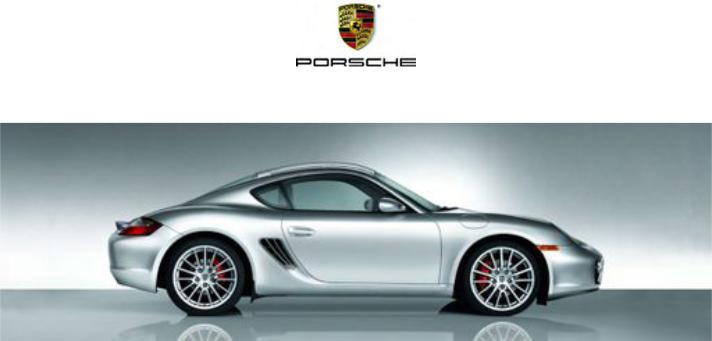
Cayman, Cayman S
Owner’s Manual
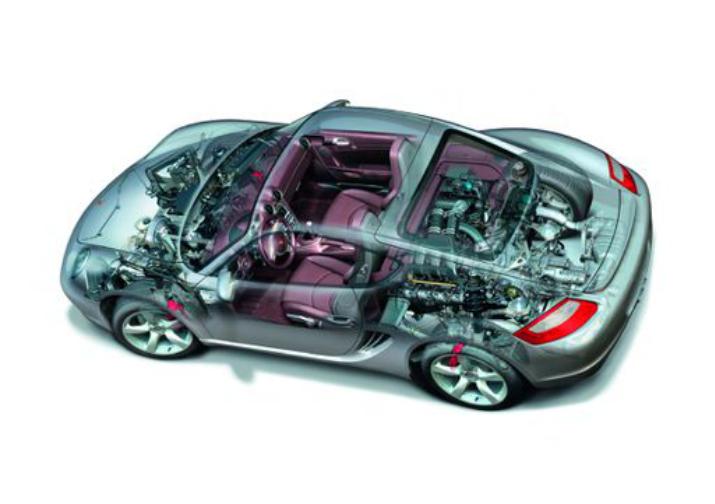
Dear Owner,
we would like to thank you for your purchase of a Porsche Sports car.
Judging by the car you have chosen, you are a motorist of a special breed, and you are probably no novice when it comes to automobiles.
Remember however, as with any vehicle, you should take time to familiarize yourself with your Porsche and its performance characteristics. Always drive within your own unique capabilities as a driver and your level of experience with your Porsche. Ensure that anyone else driving your Porsche does the same. To prevent or minimize injury, always use your safety belts. Never consume alcohol or drugs before or during the operation of your vehicle.
This Owner’s Manual contains a host of useful information. Please take the
time to read this manual before you drive your new Porsche. Become familiar with the operation of your Porsche car for maximum safety and operating pleasure. The better you know your Porsche,
the more pleasure you will experience driving your new car. Always keep your Owner’s Manual in the car, and give it to the new owner if you ever sell your Porsche.
A separate Maintenance Booklet explains how you can keep your Porsche in top driving condition by having
it serviced regularly. A separate
Warranty and Customer Information Booklet contains detailed information about the warranties covering your Porsche.
For U.S. only:
If you believe that your vehicle has a fault which could cause a crash, injury or death, you should immediately inform the National Highway Traffic Safety Administration (NHTSA) in addition to notifying Porsche Cars North America, Inc. (Porsche Cars N.A.).
If NHTSA receives similar complaints, it may open an investigation, and if it finds that a safety problem exists in a
group of vehicles, it may order a recall and remedy campaign. However, NHTSA cannot become involved in individual problems between you and your dealer, or Porsche Cars N.A..
To contact NHTSA, you may either call the Auto Safety Hotline toll-free at
1(800)424-9393 (or366-0123 in Washington, D.C. area) or write to: NHTSA, U.S. Department of Transportation, Washington, D.C. 20590. You can also obtain other information about motor vehicle safety from the Hotline.
Your car has thousands of parts and components which have been designed and manufactured in accordance with Porsche’s high standards of engineering quality and safety.
Any alteration of the vehicle may negate or interfere with those safety features built into the vehicle. Modi cations may be carried out on your vehicle only if approved by Porsche.
1

Your Porsche is intended to be used in a safe manner obeying the local laws and in the light of driving conditions faced by you, and in accordance with the instructions provided in this Owner’s Manual.
Do not misuse your Porsche by ignoring those laws and driving conditions, or by ignoring the instructions in this manual. Any alteration or misuse of the vehicle can lead to accidents and severe or fatal person al injuries.
The fitting of racing tires (e.g. slicks) for sporting events is not approved by Porsche. Very high cornering speeds can be achieved with racing tires. However, the resulting transverse acceleration values would jeopardize the adequate supply of oil to the engine. Porsche therefore will not accept
any warranty or accept any liability for damage occurring as a result of non-compliance with this provision.
Regularly check your vehicle for signs of damage. Damaged or missing aerodynamic components
such as spoilers or underside panels affect the driving behavior and therefore must be replaced immediately.
Your car may have all or some of the components described in this manual. Should you have difficulty understanding any of the explanations of features or equipment installed in your vehicle, contact your authorized Porsche dealer. He/She will be glad to assist you. Also check with your dealer on other available options or equipment.
Throughout this booklet, left is designated as the driver’s side of the vehicle, and right as the passenger’s side of the vehicle.
Text, illustrations and specifications in this manual are based on the information available at the time of printing.
It has always been Porsche’s policy to continuously improve its products. Porsche, therefore, reserves the right to make changes in design and specification, and to make additions
or improvements in its product without
incurring any obligation to install them on products previously manufactured.
We wish you many miles of safe and pleasurable driving in your Porsche.
Warning!
For your own protection and longer service life of your car, please follow all operating instructions and special warnings. These special
warnings use the safety alert symbol, followed by the words Danger, Warning and Caution. These special warnings contain important messages regarding your safety and/or the potential for damage
to your Porsche. Ignoring them could result in serious mechanical failure,serious personal injury or death.
Do not alter your Porsche. Any alteration could create dangerous conditions or defeat safety engineering features built into your car.
2

Do not misuse your Porsche. Use it safely, and consistently with the law, according to the driving conditions, and the instructions in this manual.
Alteration or misuse of your Porsche could cause accidents and severe or fatal personal injuries.
3
Imprint
WKD 987 621 07
4/06
© Dr. Ing. h.c. F. Porsche AG
Porsche, the Porsche crest, PCCB, Tiptronic and Tequipment are registered trademarks and the distinctive shapes of Porsche automobiles are trademarks of
Dr. Ing. h.c. F. Porsche AG. All rights reserved. Printed in Germany 32654
Note to owners
In Canada, this manual is also available in French. To obtain a copy contact your dealer or write to:
Note aux proprietaires
Au Canada, ce manuel est également disponible en francais. Pour en obtenir un exemplaire, adressez-vous à votre concessionnaire ou écrivez à l’adresse ci-dessous.
Porsche Cars Canada, Ltd. Automobiles Porsche Canada, LTEE
5045 Orbitor Drive Building #8, Suite 200 Mississauga, Ontario Canada L4W 4Y4
Telephone number for customer assistance: 1-800-PORSCHE / Option 3
4
Fuel Quality
Your engine is designed to provide optimum performance and fuel economy using unleaded premium fuel with an octane rating of 98 RON (93 CLC or AKI). Porsche therefore recommends the use of these fuels in your vehicle.
Porsche also recognizes that these fuels may not always be available. Be assured that your vehicle will operate properly on unleaded premium fuels with octane numbers of at least 95 RON (90 CLC or AKI), since the engine’s “Electronic Octane™ knock control” will adapt the ignition timing, if necessary.
Fuels containing alcohol and ether
Some areas of the U.S. require oxygenated fuels during certain portions of the year. Oxygenated fuels are fuels which contain alcohols (such as methanol or ethanol) or ether (such as MTBE).
Under normal conditions, the amount of these compounds in the fuel will not affect driveability.
You may use oxygenated fuels in your Porsche, provided the octane requirements for your vehicle are met. We recommend, however, that you change to a different fuel or station if any of the following problems occur with your vehicle:
–Deterioration of driveability and performance.
–Substantially reduced fuel economy.
–Vapor lock and non-start problems, especially at high altitude or at high temperature.
–Engine malfunction or stalling.
Fuels containing MMT
Some North American fuels contain an octane enhancing additive called methylcyclopentadienyl manganese tricarbonyl (MMT). If such fuels are used, your emission control system performance may be negatively affected. The check engine warning lights on your instrument panel may turn on. If this occurs, Porsche recommends you stop using fuels containing MMT.
5
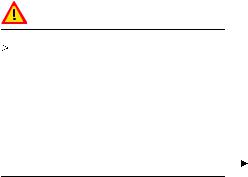
Porsche and the Environment
Environmental guidelines
We develop and produce exclusive vehicles with advanced environmental and safety technology and a great ability to fascinate.
Our environmental policy is based on the following principles:
–The maximum possible use of environmental and safety technology that is economically justifiable.
–Economical usage of energy and resources.
–Involvement of our business partners and contractors in our efforts to protect the environment.
–Open dialogue with all social groups.
California Proposition 65 Warning
Warning!
Engine exhaust, some of its constituents, and certain vehicle components contain or emit chemicals known to the State of California
to cause cancer and birth defects or other reproductive harm. In addition, certain fluids contained in vehicles and certain products of component wear contain or emit chemicals known to the State of California to cause cancer and birth defects or other reproductive harm.
Production
Whether in production or repair, Porsche always relies on environmentally friendly technology. An example of this is the water-based paint used in our painting installations. Water-base paints and new painting methods reduce solvent emissions by 70 per cent. The water used in the painting installation is recirculated. Waste water leaves the Porsche factory only after being appropriately treated.
A waste-management system has been introduced to reduce the amount of waste while simultaneously increasing the recycling rate.
Environmentally friendly vehicles
Modern environmental technology ensures compliance with all emission laws applicable worldwide.
It has the following advantages:
–Rapid operational readiness of the catalytic converters ensures low emissions, even in short-trip operation.
–Reliable operation and good emission control over a long useful life.
Please observe the chapter ”FUEL ECONOMY” on page 214.
6

Recycling - for a Porsche, this is virtually an academic question
More than two-thirds of all Porsches ever built are still running.
Just in case recycling is ever necessary, we take the following precautionary measures:
–Identification of all materials.
–Use of recyclable materials.
–Reusable components designed for simple removal.
–These reasons result in a further increase in the recycling rate which is currently 80 per cent.
Emission control is built in
Innovative engine technology combines high engine performance and environmental compatibility.
The engine diagnosis system electronically monitors the components and systems that affect exhaust gases.
This continuous monitoring and fault storage enables swift, reliable diagnosis and fault detection.
Any fault messages are indicated to the driver by the “Check Engine” warning light and the on-board computer.
Please observe the chapter ”WARNINGS ON THE INSTRUMENT PANEL AND THE ON-BOARD COMPUTER” on page 138.
7
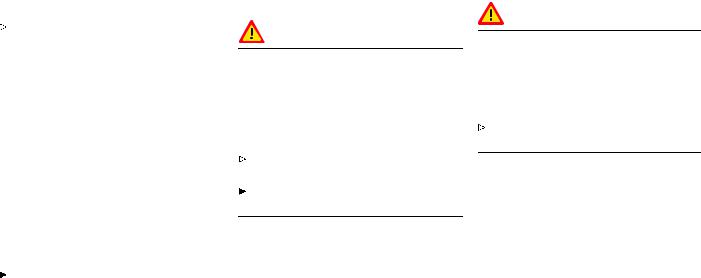
General safety instructions
Porsche Ceramic Composite Brake (PCCB)
Please observe the chapter ”BRAKES” on page 66.
The high-performance brake system is designed for optimal braking effect at all speeds and temperatures. Certain speeds, braking forces and ambient conditions (such as temperature and humidity) therefore might cause brake noises.
Wear on the diffrent components and braking system, such as brake pads and brake discs, depends to a great extent on the individual driving style and the conditions of use and therefore cannot be expressed in actual miles on the road.
The values communicated by Porsche are based on normal operation adapted to traffic. Wear increases considerably when the vehicle is driven on race tracks or through an aggressive driving style.
Please consult an authorized Porsche dealer about the current guidelines in effect before such use of your vehicle.
Setting and operation vehicle components when driving
Warning!
There is a danger of an accident if you operate or set the on-board computer, radio, navigation system, telephone or other equipment when driving. This could distract you from the traf c and cause you to lose control of the vehicle resulting in serious personal injury or death.
Operate the equipment while driving only if the traffic situation allows you to do so safely.
Carry out any complicated operating or setting procedures only with the vehicle stationary.
Portable Fuel Containers
Danger!
Portable fuel containers may leak, whether they are full or partially empty. Fuel leaking from a portable container carried in your vehicle could, in case of an accident, cause are or explosion, resulting in serious personal injury or death.
Never carry additional fuel in portable containers in your vehicle.
8
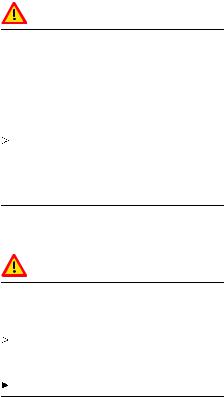
Engine Exhaust
Danger!
Engine exhaust is dangerous if inhaled. Engine exhaust fumes have many components which you can smell. They also contain carbon monoxide (CO), which is a colorless and odorless gas. Carbon monoxide can cause unconsciousness and even death if inhaled.
Never start or let the engine run in an enclosed, unventilated area. It is not recommended to sit in your car for prolonged periods with the engine on and the car not moving.
Ground Clearance
Caution!
Risk of damage. The vehicle may touch the ground as a result of reduced ground clearance.
Drive carefully and slowly on steep slopes (e.g. parking lots, curbs, uneven roads, lifting platforms, etc.).
Avoid steep ramps.
9
10
Controls, Instruments |
14 |
- 191 |
Shifting Gear |
193 |
- 199 |
Maintenance, Car Care |
201 |
- 234 |
Practical Tips, Emergency Service |
235 |
- 289 |
Vehicle Identi cation, Technical Data |
291 |
- 307 |
Index |
308 |
- 312 |
11
12
Controls, Instruments |
|
Dear Porsche Owner ...................................... |
15 |
Before driving off... ........................................ |
16 |
In the driver’s seat... ...................................... |
17 |
On the road... ................................................ |
18 |
Break in hints for the first 2000 miles/3000 |
|
kilometers .................................................... |
19 |
Never invite car theft! ..................................... |
21 |
Keys ............................................................ |
22 |
Key with Radio Remote Control ....................... |
23 |
Central Locking in Cars without Alarm System .. |
25 |
Central Locking in Cars with Alarm System ....... |
28 |
Doors .......................................................... |
31 |
Alarm System, Passenger Compartment Monitor- |
|
ing ............................................................... |
32 |
Power Windows ............................................ |
34 |
Mirrors ......................................................... |
36 |
Seat Adjustment ............................................ |
40 |
Seat Memory ................................................ |
43 |
Heated Seats ................................................ |
45 |
Steering Wheel Adjustment ............................. |
46 |
Multi-functional steering wheel ........................ |
47 |
Sun Visors .................................................... |
48 |
Safety Belts .................................................. |
49 |
Airbag Systems ............................................ |
52 |
Child Restraint Systems ................................. |
58 |
LATCH System .............................................. |
62 |
Child Restraint Anchorage .............................. |
63 |
Clutch Pedal ................................................. |
64 |
Parking Brake ............................................... |
65 |
Brakes ......................................................... |
66 |
ABS Brake System ........................................ |
69 |
Sports Exhaust System .................................. |
71 |
Sport Mode .................................................. |
72 |
Porsche Stability Management (PSM) ............... |
73 |
Porsche Active Suspension Management |
|
(PASM) ......................................................... |
76 |
Retractable Rear Spoiler ................................ |
77 |
Parking Aids ................................................. |
79 |
Interior Lights ............................................... |
81 |
Operation, Instruments .................................. |
82 |
Ignition/Starter Switch with anti-theft Steering |
|
Lock ............................................................ |
83 |
Starting and Stopping Engine .......................... |
86 |
Instrument Panel USA Models ......................... |
88 |
Instrument Panel Canada Models .................... |
90 |
Automatic Speed Control Indicator Light .......... |
92 |
Instrument Illumination ................................... |
93 |
Trip Odometer .............................................. |
94 |
Speedometer ............................................... |
95 |
Tachometer .................................................. |
96 |
Turn Signal Indicator Light .............................. |
96 |
Cooling system ............................................. |
97 |
Tiptronic S .................................................... |
98 |
Fuel ............................................................. |
99 |
Clock ......................................................... |
100 |
Battery ....................................................... |
101 |
Check Engine Warning Light ......................... |
102 |
Central Warning Light ................................... |
103 |
Brake Warning Light ..................................... |
104 |
On-Board Computer (BC) .............................. |
105 |
LIMIT Acoustic warning signal for speed limit .. |
108 |
INFO Warning messages .............................. |
111 |
TEL Telephone information ........................... |
112 |
CHRONO Stopwatch .................................... |
115 |
TPC Tire Pressure Monitoring ....................... |
122 |
OIL Display and measurement of the engine oil |
|
level ........................................................... |
131 |
SET Basic setting on on-board computer ........ |
134 |
General information regarding the on-board |
|
computer functions ..................................... |
137 |
Warnings on the instrument panel and the on-board |
|
computer ................................................... |
138 |
Light Switch ................................................ |
147 |
Welcome Home Lighting .............................. |
147 |
Automatic Headlight Beam Adjustment .......... |
148 |
Turn Signal/ Headlight Dimmer/Parking light / |
|
Flasher Lever .............................................. |
149 |
Windshield Wiper / Washer Lever .................. |
150 |
Automatic Speed Control ............................. |
153 |
Air conditioning ........................................... |
156 |
Automatic air conditioning system ................. |
159 |
Central and side vents .................................. |
162 |
Fresh-air intake ........................................... |
162 |
Emergency Flasher Switch ........................... |
163 |
Ashtray ...................................................... |
164 |
Cigarette Lighter ......................................... |
165 |
Sockets ..................................................... |
166 |
Storage in the passenger compartment ......... |
167 |
Cupholder .................................................. |
170 |
Fire extinguisher .......................................... |
172 |
Controls, Instruments 13 |
|
Trunk Entrapment ........................................ |
173 |
Front Luggage Compartment lid .................... |
174 |
Front Luggage Compartment ........................ |
176 |
Rear Lid ..................................................... |
178 |
Rear luggage compartment .......................... |
179 |
Porsche Communication Management (PCM) . 184 |
|
Car Audio Operation/Tips ............................. |
185 |
HomeLink ................................................... |
188 |
Roof Transport System ................................ |
191 |
14Controls, Instruments
Dear Porsche Owner
A lot has gone into the manufacture of your Porsche, including advanced engineering, rigid quality control and demanding inspections. These engineering and safety features will be enhanced by you...
the safe driver...
–who knows her/his car and all controls,
–who maintains the vehicle properly,
–who uses driving skills wisely, and always drives within her/his own capabilities and the level of familiarity with the vehicle.
You will find helpful hints in this manual on how to perform most of the checks listed on the following pages. If in doubt, have these checks performed by your authorized Porsche dealer.
Controls, Instruments 15

Before driving off...
Check the following items rst
Turn the engine off before you attempt any checks or repairs on the vehicle.
Be sure the tires are inflated correctly. Check tires for damage and tire wear.
See that wheel bolts are properly tightened and not loose or missing.
Check engine oil level, add if necessary. Make it a habit to have engine oil checked with every refueling.
Check all fluid levels such as windshield washer and brake fluid levels.
Be sure the vehicle battery is well charged and cranks the engine properly.
Check all doors and lids for proper operation and latch them properly.
Check and if necessary replace worn or cracked wiper blades.
See that all windows are clear and unobstructed.
Check air intake slots and area between front lid and windshield. Ensure that these areas are free of snow and ice, so the heater and the windshield wipers work properly.
If a child will be riding in the vehicle, check child seat/child seat restraint system to ensure that restraints are properly adjusted.
Check all exterior and interior lights for operation and that the lenses are clean.
Check the headlights for proper aim, and if necessary, have them adjusted.
Check under the vehicle for leaks.
Be sure all luggage is stowed securely.
Emergency equipment
It is good practice to carry emergency equipment in your vehicle. Some of the items you should have are: window scraper, snow brush, container or bag of sand or salt, emergency light, small shovel, first-aid kit, etc.
16Controls, Instruments

In the driver’s seat...
Check operation of the horn.
Position seat for easy reach of foot pedals and controls. To reduce the possibility of injury from the airbag deployment, you should always sit back as far from the steering wheel as is practical, while still maintaining full vehicle control.
Adjust the inside and outside rear view mirrors. Buckle your safety belts.
Check operation of the foot and parking brake.
Check all warning and indicator lights with ignition on and engine not running.
Start engine and check all warning displays for warning symbols.
Never leave an idling car unattended.
Lock doors from inside, especially with children in the car to prevent inadvertent opening of doors from inside or outside. Drive with doors locked.
Controls, Instruments 17
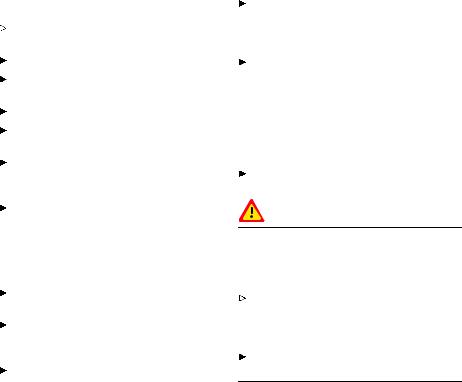
On the road...
Never drive after you have consumed alcohol or drugs.
Always have your safety belt fastened.
Always drive defensively. Expect the unexpected.
Use signals to indicate turns and lane changes.
Turn on headlights at dusk or when the driving conditions warrant it.
Always keep a safe distance from the vehicle in front of you, depending on traffic, road and weather conditions.
Reduce speed at night and during inclement weather. Driving in wet weather requires caution and reduced speeds, particularly
on roads with standing water, as the handling characteristics of the vehicle may be impaired due to hydroplaning of the tires.
Always observe speed limits and obey road signs and traffic laws.
When tired, get well off the road, stop and take a rest. Turn the engine off. Do not sit in the vehicle with engine idling.
Please observe the chapter ”ENGINE EXHAUST” on page 9.
When parked, always set the parking brake. Move the Tiptronic selector lever to ”P“ or the gearshift lever to reverse or first gear. On hills also turn the front wheels toward the curb.
When emergency repairs become necessary, move the vehicle well off the road. Turn on the emergency flasher and use other warning devices to alert other motorists. Do not park or operate the vehicle in areas where the hot exhaust system may come in contact with dry grass, brush, spilled fuel or other flammable material.
Make it a habit to have the engine oil checked with every refueling.
Danger!
Danger of re in engine compartment due to burning cigars or cigarettes. Serious personal injury or death could result fromre in the engine compartment.
Do not throw any lit cigars or cigarettes out of the vehicle. They can be blown into the air inlets by the air flow and cause a fire in the engine compartment.
Please observe the chapter ”ASHTRAY” on page 164.
18Controls, Instruments

Break in hints for the rst 2000 miles/3000 kilometers
The following tips will be helpful in obtaining optimum performance from your new Porsche.
Despite the most modern, high-precision manufacturing methods, the moving parts must still wear in with each other. This wearing-in occurs mainly in the first 2000 miles/3000 kilometers.
Therefore:
Preferably take longer trips.
Avoid frequent cold starts with short-distance driving whenever possible.
Avoid full throttle starts and abrupt stops.
Do not exceed maximum engine speed of 4200 rpm (revolutions per minute).
Do not run a cold engine at high rpm either in Neutral or in gear.
Do not let the engine labor, especially when driving uphill. Shift to the next lower gear in time (use the most favorable rpm range).
Never lug the engine in high gear at low speeds. This rule applies at all times, not just during the break-in period.
Do not participate in motor racing events, sports driving schools, etc. during the first 2000 miles/3000 kilometers.
There may be a slight stiffness in the steering, gear-shifting or other controls during the break-in period which will gradually disappear.
Break in brake pads and break discs
New brake pads and discs have to be “broken in”, and therefore only attain optimal friction when the car has covered several hundred miles or km. The slightly reduced braking ability must be compensated for by pressing the brake pedal
harder. This also applies whenever the brake pads and brake discs are replaced.
New tires
New tires do not have maximum traction. They tend to be slippery.
Break in new tires by driving at moderate speeds during the first 60 to 120 miles/100 to 200 km. Longer braking distances must be anticipated.
Engine oil and fuel consumption
During the break-in period oil and fuel consumption may be higher than normal.
As always, the rate of oil consumption depends on the quality and viscosity of oil, the speed at which the engine is operated, the climate and road conditions, as well as the amount of dilution and oxidation of the lubricant.
Make a habit of checking engine oil with every refueling, add if necessary.
Controls, Instruments 19
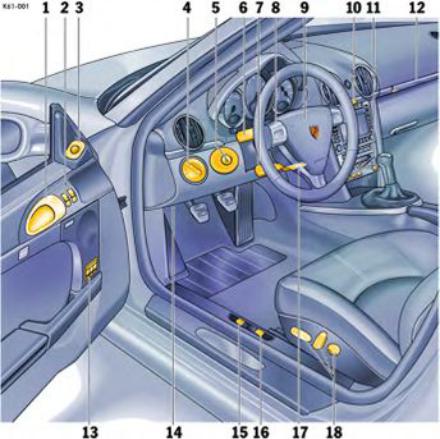
1 Inner door handle
2Power windows
3 Door mirror control
4Light switch
5Ignition / starter switch
6 Turn signal / headlight dimmer, asher lever
7Operating lever for on-board computer
8For vehicles with Tiptronic: Toggle switches for Tiptronic
9Horn
10Emergency asher switch, central locking switch
11Switches for rear spoiler, Porsche Activ Suspension Management (PASM), Sport mode, Porsche Stability Management (PSM), Sports exhaust system
12Cupholder
13Switch for seat memory
14Diagnostic socket
15Switch for front luggage compartment release
16Switch for rear lid release
17Steering-wheel adjustment
18Seat adjustment
20Controls, Instruments
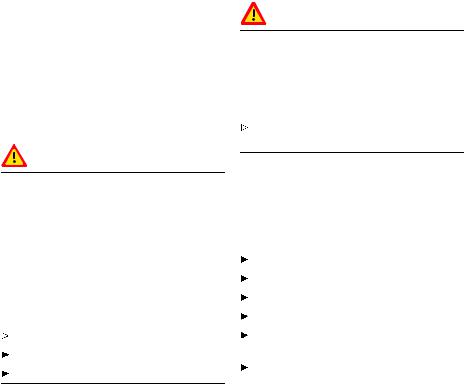
Never invite car theft!
An unlocked car with the key in the ignition lock invites car theft.
A steering wheel lock and a gong alarm are standard equipment in your Porsche. The gong alarm will sound if you open the driver’s door while the key is still in the ignition lock. It is your reminder to pull the key out of the ignition lock and to lock the doors.
Warning!
Any uncontrolled movement of the vehicle may result in property damage, serious personal injury or death. Never leave your vehicle unattended with the key in the ignition lock, especially if children and/or pets are left unattended in the vehicle. They can operate power windows and other controls. If the engine is left running, they may accidentally engage the shift lever. Serious personal injury or death could result from loss of control of the vehicle.
Always remove the ignition key.
Always set the parking brake.
Lock the doors with the remote control.
Warning!
Risk of a serious accident. The steering column will lock when you remove the key while you are driving or as the car is rolling to a stop. You will not be able to steer the car. Serious personal injury or death could result from loss of control of the vehicle.
Never remove the key from the steering lock while you are driving.
To protect your vehicle and your possessions from theft, you should always proceed as follows when leaving your vehicle:
Close windows.
Lock glove compartment.
Remove ignition key.
Close storage tray between the seats.
Remove valuables (e.g. car documents, telephone, house keys) from the car.
Lock doors.
Controls, Instruments 21

Keys
General information regarding the keys
Please observe the chapter ”ALARM SYSTEM, PASSENGER COMPARTMENT MONITORING” on page 32.
Please observe the chapter ”CENTRAL LOCKING IN CARS WITH ALARM SYSTEM” on page 28.
Two main keys and one spare key are supplied with your Porsche. These keys operate all the locks on your vehicle.
Be careful with your car keys: do not part with them except under exceptional circumstances.
To avoid battery run-down, always remove the ignition key from the ignition lock.
22Controls, Instruments
Replacement keys
Order of replacement keys
Replacement car keys can be obtained only from your authorized Porsche dealer, and this can sometimes be very time-consuming. You should therefore always keep the spare key on your person. Keep it in a safe place (e.g. wallet), but under no circumstances in or on the vehicle.
The key codes of new keys have to be “reported” to the car control unit by your authorized Porsche dealer.
A total of 6 car keys can be reported to the control unit.
Disabling key codes
If a key is lost, the key codes can be disabled by an authorized Porsche dealer. All the remaining car keys are required for this purpose. Disabling the code ensures that the car can be started only using authorized keys.
Note
Please note that the other locks can still be opened with the disabled key.
Immobilizer
There is a transponder (an electronic component) in the key grip, containing a stored code. When the ignition is switched on, the ignition lock checks the code. The immobilizer can be switched off and the
engine started only using an authorized ignition key.
Switching off the immobilizer
Insert the ignition key into the ignition lock.
If the ignition is left on for more than 2 minutes without the engine being started, the immobilizer is switched on again.
If this happens, turn the ignition key to the left before starting the engine. The immobilizer is switched off again, and the engine can be started.
Please observe the chapter ”IGNITION/START- ER SWITCH WITH ANTI-THEFT STEERING LOCK” on page 83.
Switching on the immobilizer
Remove ignition key.
Security wheel bolts
If wheels have to be removed during a repairshop visit, do not forget to hand over the socket for the security wheel bolts along with the car key.
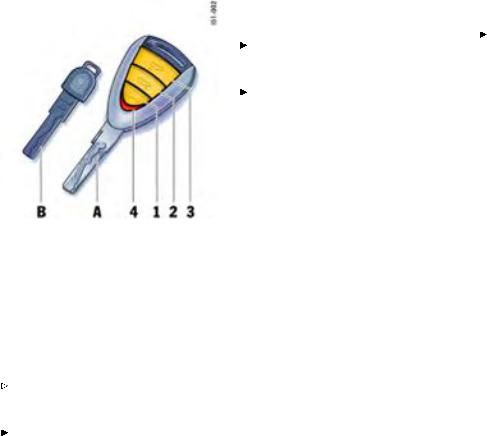
Switching off the alarm system if it is triggered accidentally
Press button 1.
Unlocking front luggage compartment
Press button 2 for approx. two seconds.
A- Main key
1- Central locking button
2 - Button for front luggage compartment lid
3 - Button for rear lid
4 - Light-emitting diode
B- Spare key
Key with Radio Remote Control
Unlocking the vehicle
Press button 1.
Locking the vehicle
Press button 1.
Unlocking rear lid
Press button 3 for approx. two seconds.
If the vehicle was locked before the luggage compartment is opened, it is unlocked simultaneously with the luggage compartment. In vehicles with seat memory the stored seat and door mirror positions are automatically set. The vehicle will be locked again approx. 15 seconds after the luggage compartment is closed if none of the doors was opened.
Note
Your authorized Porsche dealer can program further types of unlocking.
Type 1
The relocking time of the doors can be adjusted to suit your individual requirements (4 - 120 seconds).
Type 2
The doors stay locked when the luggage compartments are unlocked.
Malfunction of the remote control
The remote control may not function correctly due to local radio wave interference. The vehicle will then not lock properly. This can be identified by the missing locking sound and the missing check-back signal of the hazard warning lights.
If this should occur:
Controls, Instruments 23

Lock the vehicle with the key in the door.
The remote-control standby function switches off after 7 days
If the vehicle is not started or unlocked with the remote control within five days, the remote
control standby function is switched off (to prevent discharging of the car battery).
1.In this case, unlock the driver’s door with the key at the door lock. Leave the door closed in order to prevent the alarm system from being triggered.
2.Press button 1 on the remote control.
The remote control is now activated again and the alarm system is switched off.
Note
Do not insert the ignition key into the ignition lock if the vehicle battery is discharged. The ignition key can no longer be removed.
The key cannot be removed until the vehicle electrical system is supplied with power again.
Please observe the chapter ”EMERGENCY UNLOCKING OF THE FRONT LUGGAGE COMPARTMENT LID” on page 260.
Please observe the chapter ”EMERGENCY STARTING WITH JUMPER CABLES” on page 267.
24Controls, Instruments
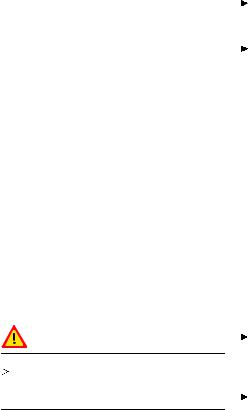
Central Locking in Cars without Alarm System
General information regarding central locking
This device complies with: Part 15 of the FCC Rules RSS-210 of Industry Canada.
Operation is subject to the following two conditions:
1.This device may not cause harmful interference, and
2.this device must accept any interference received, including interference that may cause undesired operation.
Note
The manufacturer is not responsible for any radio or TV interference caused by unauthorized
modifications to this equipment. Such modification could void the user’s authority to operate the equipment.
Warning!
Any changes or modifications not expressly approved by Porsche could void the user’s authority to operate this equipment.
Please observe the chapter ”LOAD SWITCH- OFF AFTER 2 HOURS OR 7 DAYS” on page 259.
Please observe the chapter ”SEAT MEMORY” on page 43.
Both car doors and the filler flap can be centrally unlocked or locked with the remote control.
Any person remaining in the locked car can open the door with the inner door handle:
3.Pull inner door handle once to unlock door lock.
4.Pull inner door handle again to open door.
Automatic relocking
If the car is unlocked by remote control and none of the car doors is opened within approx.
60 seconds, automatic relocking takes place. This relocking time can be adapted to your individual requirements (4 - 120 seconds) by an authorized Porsche dealer.
Emergency operation - opening
Unlock the driver’s door with the key at the door lock.
Emergency operation - closing
Lock the driver’s door with the key at the door lock. If there is a defect in the central locking system, all functioning elements of the central locking system will be locked.
The fault should be remedied immediately at an authorized Porsche dealer.
Indication by emergency asher
If the remote control is used for unlocking or locking, a response is provided by the emergency flasher:
–Unlocking - single flash.
–Locking - double flash.
Overload protection
If the central locking system is operated more than ten times within a minute, further operation is blocked for 30 seconds.
Controls, Instruments 25
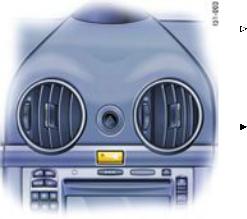
 Central locking switch
Central locking switch
The central locking switch on the dashboard lets you lock and unlock both doors electrically.
Note
If the doors are locked with the key or remote control, they can not be opened by pressing the central locking switch.
26Controls, Instruments
Locking
Press the rocker-switch. Indicator light in the rocker switch lights up if ignition is on. If the doors were locked with the central locking switch, they can be opened by pulling the inner door handle twice.
Unlocking
Press the rocker-switch. Indicator light goes off.
Automatic door locking
Your authorized Porsche dealer can program diverse types of automatic door locking in the control unit of the central locking system.
Type 1
Doors lock automatically when the ignition is switched on.
Type 2
Doors lock automatically when a speed of 3 - 6 mph (5 - 10 km/h) is exceeded.
Type 3
Doors lock automatically when the ignition is switched on. If doors are opened with the engine running, they lock again automatically when a speed of 3 - 6 mph (5 - 10 km/h) is exceeded.
Type 4
The doors do not lock automatically.
Note
Automatically locked doors can be unlocked with the central locking button or opened by pulling on the inside door handle twice.
On vehicles with the Sport Chrono Package Plus, the PCM can be used to activate automatic door locking.
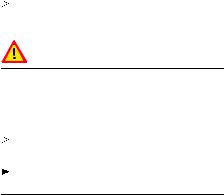
Please observe the chapter “Individual Memory” in the separate PCM operating instructions.
Warning!
In an emergency situation where you need to exit the car through an automatically locked door, remember the following procedure to open the door.
Unlock the doors by pressing the central locking button or
pull the inside door handle twice to open the door.
Controls, Instruments 27
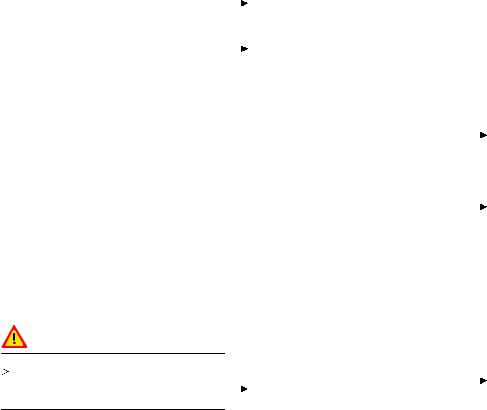
Central Locking in Cars with Alarm System
General information regarding central locking
This device complies with: Part 15 of the FCC Rules RSS-210 of Industry Canada.
Operation is subject to the following two conditions:
1.This device may not cause harmful interference, and
2.this device must accept any interference received, including interference that may cause undesired operation.
Note
The manufacturer is not responsible for any radio or TV interference caused by unauthorized
modifications to this equipment. Such modification could void the user’s authority to operate the equipment.
Warning!
Any changes or modifications not expressly approved by Porsche could void the user’s authority to operate this equipment.
28Controls, Instruments
Please observe the chapter ”LOAD SWITCH- OFF AFTER 2 HOURS OR 7 DAYS” on page 259.
Please observe the chapter ”SEAT MEMORY” on page 43.
Both car doors and the filler flap can be centrally unlocked or locked with the remote control.
The vehicle cannot be locked if the driver’s door is not completely closed.
A short signal from the alarm horn will draw your attention to the fact that the following components are not completely closed when you try to lock the vehicle:
–Doors
–Luggage compartment lids
–Glove compartment
–Passenger compartment
Unlocking the vehicle by using the key in the door lock and opening the door may activate the alarm system within 10 seconds.
Note
On vehicles with the Sport Chrono Package Plus, the PCM can be used to activate automatic door locking.
Please observe the chapter “Individual Memory” in the separate PCM operating instructions.
Automatic relocking
If the car is unlocked by remote control and none of the car doors is opened within approx.
60 seconds, automatic relocking takes place. This relocking time can be adapted to your individual requirements (4 - 120 seconds) by an authorized Porsche dealer.
Locking conditions
Lock car once. The doors cannot be opened from the outside. Alarm system and passenger compartment monitoring are switched on.
If a person or animal remains in the vehicle:
Quickly lock car twice: The doors cannot be opened from the outside. The passenger compartment monitoring is switched off.
Unlocking the door with the inner door handle
Any person remaining in the locked car can open the door with the inner door handle:
1.Pull inner door handle once to unlock door lock.
2.Pull inner door handle again to open door.
Note
Inform any person remaining in the car that the alarm system will be triggered if the door is opened.
